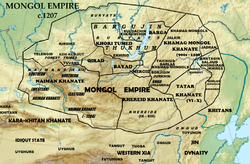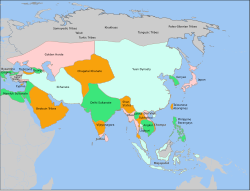World History empires name meanings study guide: Difference between revisions
m (→Mongol empires) |
|||
| Line 3: | Line 3: | ||
* along with memorizing names, places (map literacy) and dates | * along with memorizing names, places (map literacy) and dates | ||
* historical knowledge and test-day recollection can be enhanced through etymology, or word origins of key historical places, empires or dynasties | * historical knowledge and test-day recollection can be enhanced through etymology, or word origins of key historical places, empires or dynasties | ||
== Concepts & notes == | |||
=== Cultural Diffusion: are conquerors eventually conquered by the conquered? === | |||
* a common thread to studies of rise and fall of empires and dynasties is cultural diffusion | |||
** cultural diffusion = the spreading and mixing of cultures, populations, technologies, disease, etc. | |||
* we will see in this review over and over how many conquerors become more like the people and places they conquered than what / who they were at the start of the conquest | |||
== China empires/ dynasties == | == China empires/ dynasties == | ||
| Line 125: | Line 133: | ||
* upon Genghis Khan's death the empire was divided into four "fragment" empires: | * upon Genghis Khan's death the empire was divided into four "fragment" empires: | ||
[[File:Asia in 1335.svg|thumb|Asia in 1335, showing the four "Khanates", successor empires to the Mongol Empire, often referred to as "fragments" of it.|alt=Relict states of the Mongol Empire|none|250x250px]] | [[File:Asia in 1335.svg|thumb|Asia in 1335, showing the four "Khanates", successor empires to the Mongol Empire, often referred to as "fragments" of it. The four "khanates" are | ||
*Yuan Dynasty | |||
* Golden Horde | |||
* Chagatai Khanate | |||
* Ilkhanate Khanate | |||
|alt=Relict states of the Mongol Empire|none|250x250px]] | |||
|- | |- | ||
| | | | ||
=== Yuan Dynasty === | === Yuan Dynasty === | ||
|see above under China dynasties for Yuan | |see above under China dynasties for Yuan | ||
| | |1271–1368 | ||
| | | | ||
| | | | ||
| Line 176: | Line 187: | ||
|- | |- | ||
| | | | ||
=== Ilkhanate Khanate === | |||
| | | | ||
* Illkhanid is from "Iran-zamin" for "Land of Iran" | |||
|1256–1335 | |||
|Persia & Middle East | |||
| | | | ||
* southwestern portion of the Mongol Empire | |||
* the shortest-lived of the four fragmented Khanates, principally due to the larger historical experience of exchange, conquest, and mixing of cultures in the Middle East, as well as its location as central Eurasian/African crossroads. | |||
|- | |- | ||
| | | | ||
Revision as of 16:22, 4 January 2023
Goal of this article is to help students identify context and historical recollection via definitions of historical names and terms
- along with memorizing names, places (map literacy) and dates
- historical knowledge and test-day recollection can be enhanced through etymology, or word origins of key historical places, empires or dynasties
Concepts & notes[edit | edit source]
Cultural Diffusion: are conquerors eventually conquered by the conquered?[edit | edit source]
- a common thread to studies of rise and fall of empires and dynasties is cultural diffusion
- cultural diffusion = the spreading and mixing of cultures, populations, technologies, disease, etc.
- we will see in this review over and over how many conquerors become more like the people and places they conquered than what / who they were at the start of the conquest
China empires/ dynasties[edit | edit source]
| Name | Name definition | Dates | Region | Notes |
|---|---|---|---|---|
| Chinese dynasties follow four general categories of name origins: |
|
| ||
Yuan Dynasty[edit | edit source] |
|
1271–1368 |
| |
Ming Dynasty[edit | edit source] |
|
1368-1644 |
| |
Qing Dynasty[edit | edit source] |
|
1644–1911 | Manchuria, China |
|
Mongol empires[edit | edit source]
| Name | Name definition | Dates | Region | Notes | |
|---|---|---|---|---|---|
Mongol Empire[edit | edit source] |
|
1206–1368 | Eurasia |

 | none |
Yuan Dynasty[edit | edit source] |
see above under China dynasties for Yuan | 1271–1368 | |||
Golden Horde (Mongol)[edit | edit source] |
|
| |||
Chagatai Khanate[edit | edit source] |
|
1242-1347 /
1347-1487 |
| ||
Ilkhanate Khanate[edit | edit source] |
|
1256–1335 | Persia & Middle East |
| |
Europe monarchies/ empires[edit | edit source]
India empires[edit | edit source]
| Name | Name definition | Dates | Region | Notes |
|---|---|---|---|---|
| Timurid Empire |
|
1370–1507 | Persia (Iran), central Aisa, northern India |
|
| Mughal Empire |
|
1526–1857 |
Middleastern empires[edit | edit source]
| Name | Name definition | Dates | Region | Notes |
|---|---|---|---|---|
| Ottoman Empire |
